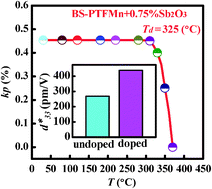Electrical properties of Sb2O3-modified BiScO3–PbTiO3-based piezoelectric ceramics
Abstract
Compared with pure Pb-based perovskite ferroelectric materials, BiMeO3–PbTiO3 (Me = Sc3+, In3+, and Yb3+) systems have remarkable advantages in their Curie temperatures. As a member of this group, the BiScO3–PbTiO3 (BS–PT) solid solution has drawn considerable attention from scientists for its high Curie temperature and excellent piezoelectric coefficient. However, BS–PT ceramics still have some shortcomings, such as high dielectric loss and low mechanical quality factor, which make them unsuitable for high-temperature applications. Herein, we report the effect of the addition of complex ions on the electrical properties of BS–PT ceramics. Sb2O3-doped 0.36BiScO3–0.64PbTi0.97Fe0.03O3 + 1 mol% MnO2 (BS–PTFMn + x% Sb2O3) ceramics were fabricated and their electrical properties were studied. BS–PTFMn + 0.75% Sb2O3 had an optimal piezoelectric coefficient, exhibiting  which indicates that Sb2O3 doping can improve the piezoelectric properties of the BS–PT ceramics, exhibiting a “soft” effect of Sb2O3 doping. In addition, the thermal depolarization temperature (Td) of BS–PTFMn + 0.75% Sb2O3 ceramics remained above 300 °C, such as 325 °C for BS–PTFMn + 0.75% Sb2O3. It was concluded that the piezoelectric properties of BS–PT ceramics were enhanced by the addition of Sb2O3.
which indicates that Sb2O3 doping can improve the piezoelectric properties of the BS–PT ceramics, exhibiting a “soft” effect of Sb2O3 doping. In addition, the thermal depolarization temperature (Td) of BS–PTFMn + 0.75% Sb2O3 ceramics remained above 300 °C, such as 325 °C for BS–PTFMn + 0.75% Sb2O3. It was concluded that the piezoelectric properties of BS–PT ceramics were enhanced by the addition of Sb2O3.

- This article is part of the themed collection: Editors' Collection: Ferroelectric and Multiferroic Materials


 Please wait while we load your content...
Please wait while we load your content...